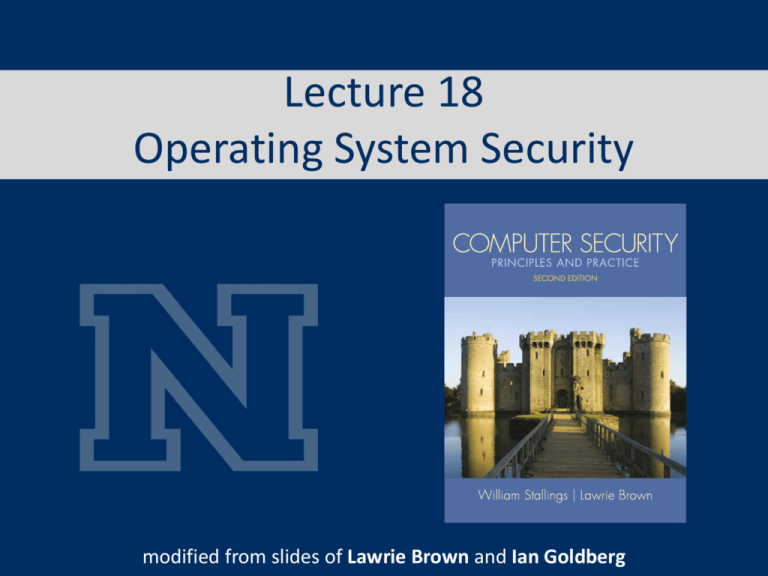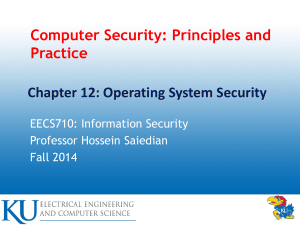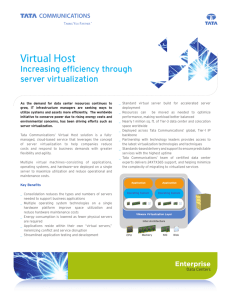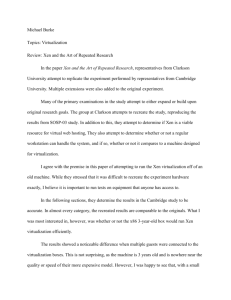Computer Security: Principles and Practice, 1/e
advertisement

Lecture 18 Operating System Security modified from slides of Lawrie Brown and Ian Goldberg Operating System • An OS allows different users to access different resources in a shared way • The OS needs to control – the sharing and – provide an interface to allow the access • Identification and authentication are required for access control 2 History • OSs evolved as a way to allow multiple users use the same hardware – Sequentially (based on executives) – Interleaving (based on monitors) • OS makes resources available to users – if required by them and permitted by some policy • OS also protects users from each other – attacks, mistakes, resource overconsumption • Even for a single-user OS, protecting a user from him/herself is a good thing – mistakes, malware 3 Separation • Keep one user's objects separate from other users • Physical separation – Use different physical resources for different users – Easy to implement, but expensive and inefficient • Temporal separation – Execute different users' programs at different times • Logical separation – User is given the impression that no other users exist – As done by an operating system • Cryptographic separation – Encrypt data and make it unintelligible to outsiders – Complex 4 Sharing • Sometimes, users want to share resources – Library routines (e.g., libc) – Files or database records • OS should allow flexible sharing, not “all or nothing” – Which files or records? • Which part of a file/record? – Which other users? • Can other users share objects further? – What uses are permitted? • Read but not write, view but not print (feasibility?) • Aggregate information only – For how long? 5 Operating System Security Layers • each layer of code needs measures in place – to provide appropriate security services • each layer is vulnerable to attack from below – if the lower layers are not secured appropriately 6 Measures • the 2010 Australian Defense Signals Directorate (DSD) list the “Top 35 Mitigation Strategies” – over 70% of the targeted cyber intrusions investigated by DSD in 2009 could have been prevented • the top four measures for prevention are: – – – – patch operating systems and applications using auto-update patch third-party applications restrict admin privileges to users who need them white-list approved applications 7 Operating System Security • possible for a system to be compromised during the installation process – before it can install the latest patches • building and deploying a system should be a planned process designed to counter this threat • process must: – assess risks and plan the system deployment – secure the underlying operating system and then the key applications – ensure any critical content is secured – ensure appropriate network protection mechanisms are used – ensure appropriate processes are used to maintain security 8 System Security Planning • the first step in deploying a new system is planning • planning should include a wide security assessment of the organization – aim is to maximize security while minimizing costs • planning process needs to determine security requirements – for the system, applications, data, and users • plan needs to identify appropriate personnel and training to install and manage the system 9 NIST System Security Planning • the purpose of the system, the type of information stored, the applications and services provided, and their security requirements • the categories of users of the system, the privileges they have, and the types of information they can access • how the users are authenticated • how access to the information stored on the system is managed • what access the system has to information stored on other hosts, such as file or database servers, and how this is managed • who will administer the system, and how they will manage the system (via local or remote access) • any additional security measures required on the system, including the use of host firewalls, anti-virus or other malware protection mechanisms, and logging 10 Operating System Hardening 11 Operating Systems Hardening • first critical step in securing a system is to secure the base operating system • NIST basic steps – install and patch the operating system – harden and configure the operating system to adequately address the indentified security needs of the system – install and configure additional security controls, such as anti-virus, host-based firewalls, and intrusion detection system (IDS) – test the security of the basic operating system to ensure that the steps taken adequately address its security needs 12 Initial Setup and Patching • system security begins with the installation of the OS – ideally new systems should be constructed on a protected network – full installation and hardening process should occur before the system is deployed to its intended location • initial installation should install the minimum necessary for the desired system • overall boot process must also be secured • the integrity and source of any additional device driver code must be carefully validated • critical that the system be kept up to date, with all critical security related patches installed – should stage and validate all patches on the test systems before deploying them in production 13 Remove Unnecessary Services, Applications, Protocols • if fewer software packages are available to run the risk is reduced – system planning process should identify what is actually required for a given system • when performing the initial installation the supplied defaults should not be used – default configuration is set to maximize ease of use and functionality rather than security – if additional packages are needed later they can be installed when they are required • not installing unwanted software – many uninstall scripts fail to completely remove all components – disabled service might be enabled by an attacker who got in 14 Configure Users, Groups, and Authentication • not all users with access to a system will have the same access to all data and resources on that system – elevated privileges should be restricted to only those users that require them, and then only when they are needed to perform a task • system planning process should consider: – – – – categories of users on the system privileges they have types of information they can access how and where they are defined and authenticated • default accounts included as part of the system installation should be secured – those that are not required should be either removed or disabled • policies that apply to authentication credentials configured 15 Configure Resource Controls • once the users and groups are defined, appropriate permissions can be set on data and resources • many of the security hardening guides provide lists of recommended changes to the default access configuration 16 Install Additional Security Controls • further security possible by installing and configuring additional security tools: – anti-virus software – host-based firewalls – IDS or IPS software – application white-listing 17 Test the System Security • final step in the process of initially securing the base OS is security testing – ensure previous security configuration steps are correctly implemented – identify any possible vulnerabilities • checklists are included in security hardening guides • there are programs specifically designed to: – review a system to ensure that a system meets the basic security requirements – scan for known vulnerabilities and poor configuration practices • should be done following the initial hardening of the system • repeated periodically as part of security maintenance process 18 Application Security 19 Application Configuration • may include: – creating and specifying appropriate data storage areas for application – making appropriate changes to the application or service default configuration details • some applications or services may include: – default data, scripts, user accounts • of particular concern with remotely accessed services such as Web and file transfer services – risk from this form of attack is reduced by ensuring that most of the files can only be read by the server 20 Encryption Technology • a key enabling technology that may be used to secure data both in transit and when stored • must be configured – appropriate cryptographic keys created, signed, and secured • if secure network services are provided using TLS or IPsec suitable public and private keys must be generated • if secure network services are provided using SSH, appropriate server and client keys must be created • cryptographic file systems are another use of encryption 21 Security Maintenance 22 Security Maintenance • process of maintaining security is continuous • NIST security maintenance: – monitoring and analyzing logging information – performing regular backups – recovering from security compromises – regularly testing system security – using appropriate software maintenance processes • to patch and update all critical software, and • to monitor and revise configuration as needed 23 Logging • can only inform you about bad things that have already happened • in the event of a system breach or failure – administrators can more quickly identify what happened • key is to ensure you capture the correct data – and then appropriately monitor and analyze this data • information can be generated by the system, network and applications • range of data acquired should be determined – during the system planning stage • generates significant volumes of information – and it is important that sufficient space is allocated for them • automated analysis is preferred 24 Data Backup and Archive • performing regular backups is a critical control – that assists with maintaining the integrity of the system and user data • may be legal or operational requirements for the retention of data • backup – process of making copies of data at regular intervals • archive – process of retaining copies of data over extended periods of time • to meet legal and operational requirements 25 Data Backup and Archive • needs and policy relating to backup and archive should be determined during the system planning stage – kept online or offline – stored locally or transported to a remote site • trade-offs include ease of implementation and cost versus greater security and robustness against different threats 26 Virtualization 27 Virtualization • a technology that provides an abstraction of the resources used by some software – which runs in a simulated environment called a virtual machine (VM) • benefits include better efficiency in the use of the physical system resources • provides support for multiple distinct operating systems and associated applications on one physical system • raises additional security concerns 28 Virtualization Alternatives • application virtualization – allows applications written for one environment to execute on some other operating system • full virtualization – multiple full operating system instances execute in parallel • virtual machine monitor (VMM) – hypervisor – coordinates access between each of the guests and the actual physical hardware resources 29 Native Virtualization Security Layers 30 Hosted Virtualization Security Layers 31 Virtualization Security Issues • security concerns include: – guest OS isolation • ensuring that programs executing within a guest OS may only access and use the resources allocated to it – guest OS monitoring by the hypervisor • which has privileged access to the programs and data in each guest OS – virtualized environment security • particularly image and snapshot management which attackers may attempt to view or modify 32 Securing Virtualization Systems • organizations using virtualization should: – carefully plan the security of the virtualized system – secure all elements of a full virtualization solution and maintain their security – ensure that the hypervisor is properly secured – restrict and protect administrator access to the virtualization solution 33 Hypervisor Security • should be – secured using a process similar to securing an OS – installed in an isolated environment – configured so that it is updated automatically – monitored for any signs of compromise – accessed only by authorized administration 34 Hypervisor Security • may support both local and remote administration so must be configured appropriately • remote administration access should be considered and secured in the design of any network firewall and IDS capability in use • ideally administration traffic should use a separate network with very limited access provided from outside the organization 35 Virtualization Infrastructure Security • systems manage access to hardware resources • access must be limited to just the appropriate guest • access to VM image and snapshots must be carefully controlled 36 Summary • • system security planning operating systems hardening – – – – • application security – – – – • initial setup and patching remove unnecessary services configure users and groups test system security application configuration encryption technology security maintenance data backup virtualization security – virtualization alternatives 37 Linux Security 38 Linux/Unix Security • patch management – keeping security patches up to date is a widely recognized and critical control for maintaining security – application and service configuration • most commonly implemented using separate text files for each application and service • generally located either in the /etc directory or in the installation tree for a specific application • individual user configurations that can override the system defaults are located in hidden “dot” files in each user’s home directory – most important changes needed to improve system security are to disable services and applications that are not required 39 Linux/Unix Security • users, groups, and permissions – access is specified as • granting read, write, and execute permissions • to each of owner, group, and others • for each resource – guides recommend changing the access permissions for critical directories and files – local exploit: software vulnerability that can be exploited by an attacker to gain elevated privileges – remote exploit: software vulnerability in a network server that could be triggered by a remote attacker 40 Linux/Unix Security remote access controls • several host firewall programs may be used • most systems provide an administrative utility to select which services will be permitted to access the system logging and log rotation • should not assume that the default setting is necessarily appropriate 41 Linux/Unix Security • chroot jail – restricts the server’s view of the file system to just a specified portion – uses chroot system call to confine a process by mapping the root of the filesystem to some other directory – file directories outside the chroot jail aren’t visible or reachable – main disadvantage is added complexity 42 Windows Security 43 Windows Security • patch management – “Windows Update” and “Windows Server Update Service” assist with regular maintenance and should be used – third party applications also provide automatic update support • users administration and access controls – systems implement discretionary access controls resources – Vista and later systems include mandatory integrity controls – objects are labeled as being of low, medium, high, or system integrity level – system ensures the subject’s integrity is equal or higher than the object’s level – implements a form of the Biba Integrity model 44 Users Administration and Access Controls • Windows systems also define privileges – system wide and granted to user accounts • combination of share and NTFS permissions may be used to provide additional security and granularity when accessing files on a shared resource • User Account Control (UAC) – assists with ensuring users with administrative rights only use them when required, otherwise accesses the system as a normal user • Low Privilege Service Accounts – used for long-lived service processes such as file, print, and DNS services 45 Windows Security • application and service configuration – much of the configuration information is centralized in the Registry • forms a database of keys and values that may be queried and interpreted by applications – registry keys can be directly modified using the “Registry Editor” • more useful for making bulk changes 46 Windows Security • other security controls – essential that anti-virus, anti-spyware, personal firewall, and other malware and attack detection and handling software packages are installed and configured – current generation Windows systems include basic firewall and malware countermeasure capabilities – important to ensure the set of products in use are compatible • Windows systems also support a range of cryptographic functions: – encrypting files and directories using the Encrypting File System (EFS) – full-disk encryption with AES using BitLocker • “Microsoft Baseline Security Analyzer” – free, easy to use tool that checks for compliance with Microsoft’s security recommendations 47




